Thanksgiving celebrates gratitude with family feasts in the United States and Canada, while Harvest Festival honors the abundance of crops with community gatherings worldwide. Discover the unique traditions and historical roots of both celebrations in this article.
Table of Comparison
| Aspect | Thanksgiving | Harvest Festival |
|---|---|---|
| Origin | United States and Canada, celebrating Pilgrims' 1621 harvest feast | Global, ancient tradition to honor the harvest season |
| Date | Fourth Thursday of November (US), Second Monday of October (Canada) | Varies by culture and region, often autumn months |
| Purpose | Giving thanks for a successful harvest and blessings | Thanksgiving for the harvest and seasonal abundance |
| Typical Foods | Turkey, stuffing, cranberry sauce, pumpkin pie | Seasonal fruits, vegetables, grains, local specialties |
| Cultural Elements | Parades, football games, family gatherings | Local ceremonies, dances, music, communal feasts |
| Religious Significance | Originally religious gratitude, now mostly secular | Often spiritual or religious rituals tied to harvest gods |
Introduction: Understanding Thanksgiving and Harvest Festivals
Thanksgiving and Harvest Festivals both celebrate gratitude for a bountiful harvest, with Thanksgiving rooted in American history and emphasizing family gatherings and feasting. Harvest Festivals, observed worldwide, reflect local customs marking the end of the growing season, often incorporating communal rituals and seasonal foods. Your appreciation of these traditions enriches the understanding of diverse cultural expressions and holiday practices around harvest time.
Historical Origins of Thanksgiving
Thanksgiving originates from early 17th-century pilgrim celebrations in Plymouth Colony, where settlers expressed gratitude for successful harvests after enduring harsh conditions. Harvest festivals, by contrast, are ancient, global traditions marking seasonal crop gathering with diverse cultural rituals dating back thousands of years. Your understanding of these holidays enriches appreciation for the distinct historical and cultural contexts shaping modern Thanksgiving as a uniquely American holiday tradition.
Historical Roots of Harvest Festivals Worldwide
Harvest festivals date back thousands of years, originating as communal celebrations of agricultural abundance across diverse cultures worldwide, including ancient Egypt, China, and Native American tribes. Thanksgiving in the United States evolved from these harvest customs, specifically linked to the early Pilgrims' 1621 feast with the Wampanoag people. Your understanding of holiday traditions deepens by recognizing the shared historical roots of gratitude, seasonal cycles, and communal feasting that connect Thanksgiving with global harvest festivals.
Key Traditions of Thanksgiving
Thanksgiving centers around key traditions such as a shared feast featuring turkey, stuffing, and pumpkin pie, symbolizing gratitude for the harvest and blessings. Families often gather to express thanks, watch parades like the Macy's Thanksgiving Day Parade, and enjoy football games, reinforcing community and cultural bonds. Unlike the broader, more localized celebrations of Harvest Festivals or diverse Holiday traditions, Thanksgiving uniquely combines historical commemoration with modern rituals focused on gratitude and togetherness.
Common Practices in Global Harvest Festivals
Global harvest festivals share common practices such as feasting on seasonal crops, expressing gratitude for a bountiful harvest, and engaging in communal activities like music, dance, and rituals. These celebrations often include offerings to deities or ancestors, symbolizing respect and hope for future abundance. Similar to Thanksgiving in the United States, many cultures incorporate storytelling, family gatherings, and traditional foods made from freshly harvested produce.
Symbolic Foods and Their Meanings
Thanksgiving centers on symbolic foods like turkey, representing abundance and gratitude, and pumpkin pie, symbolizing the harvest season's bounty. Harvest Festivals typically emphasize seasonal produce such as corn, apples, and squash, highlighting community celebration of agricultural cycles. Your participation in these holiday traditions connects you to cultural heritage through the meaningful consumption of these emblematic dishes.
Regional Variations: Thanksgiving vs. Harvest Festivals
Thanksgiving is primarily celebrated in the United States and Canada, with distinct regional dishes like turkey and pumpkin pie reflecting local agricultural products and historical influences. Harvest festivals, common worldwide, vary greatly by region, often featuring local crops and traditional rituals tied to the agricultural calendar, such as rice harvest celebrations in Asia or grape festivals in Mediterranean countries. Your experience of these events depends largely on your location, as each festival embodies unique customs and seasonal specialties rooted in regional culture and history.
Cultural and Religious Significance
Thanksgiving is a North American celebration rooted in historical gratitude and harvest blessings, emphasizing cultural traditions such as feasting and family gatherings. The Harvest Festival, observed in various cultures worldwide, often carries strong religious significance, honoring deities or nature's bounty through rituals and communal ceremonies. Holiday traditions encompass a broader range of cultural and religious observances, reflecting diverse values and spiritual practices that shape community identity and seasonal celebrations.
Modern Celebrations and Adaptations
Modern Thanksgiving celebrations emphasize family gatherings, hearty meals centered around turkey, and expressions of gratitude, often incorporating diverse cultural influences. Harvest Festivals today blend traditional agricultural rituals with community events such as fairs, music, and local food markets, reflecting regional customs and sustainability trends. Holiday traditions adapt to contemporary lifestyles through virtual gatherings, multicultural inclusivity, and eco-friendly practices, ensuring relevance and accessibility across varied demographics.
Comparing the Impact on Community and Family
Thanksgiving, Harvest Festival, and Holiday traditions each uniquely strengthen community and family bonds through shared meals, rituals, and gratitude expressions. Thanksgiving typically centers on family gatherings with a focus on gratitude and historical reflection, fostering intimate connections within households. In contrast, Harvest Festivals emphasize communal celebration of agricultural abundance, enhancing community solidarity through public events, while broader Holiday traditions combine various cultural practices that unite both family and community across diverse social contexts.

Infographic: Thanksgiving vs Harvest Festival
 relatioo.com
relatioo.com